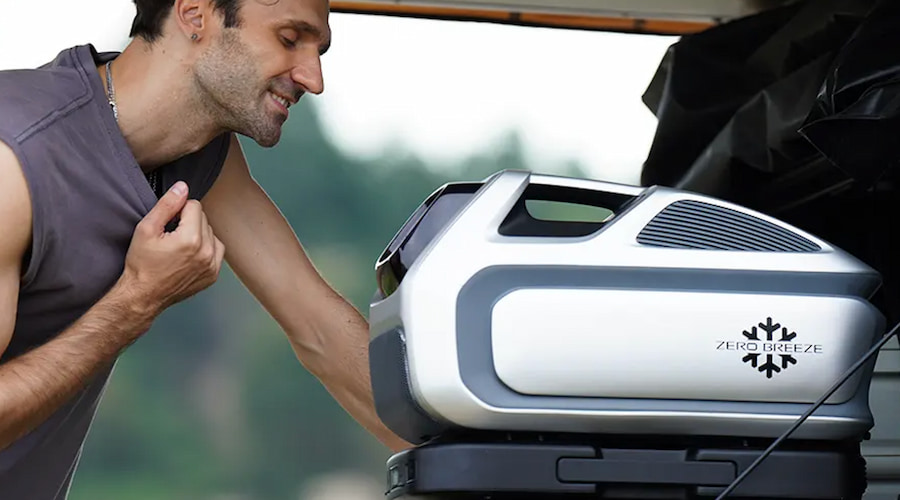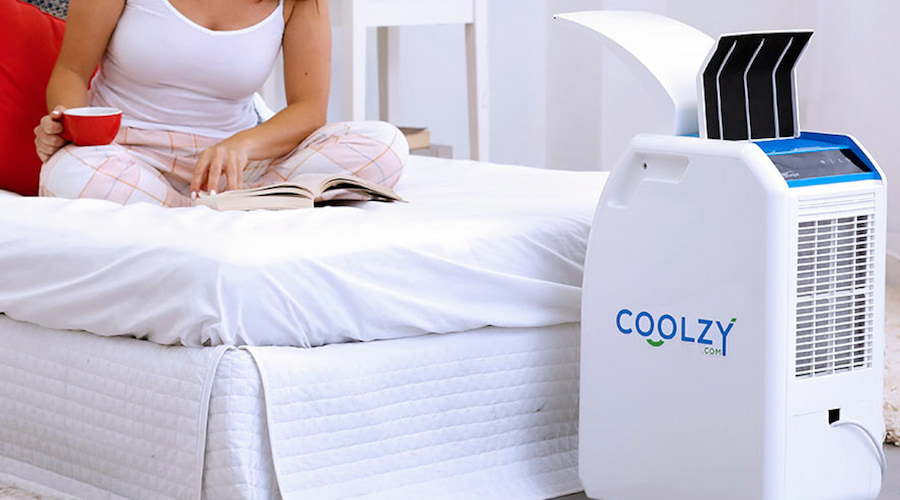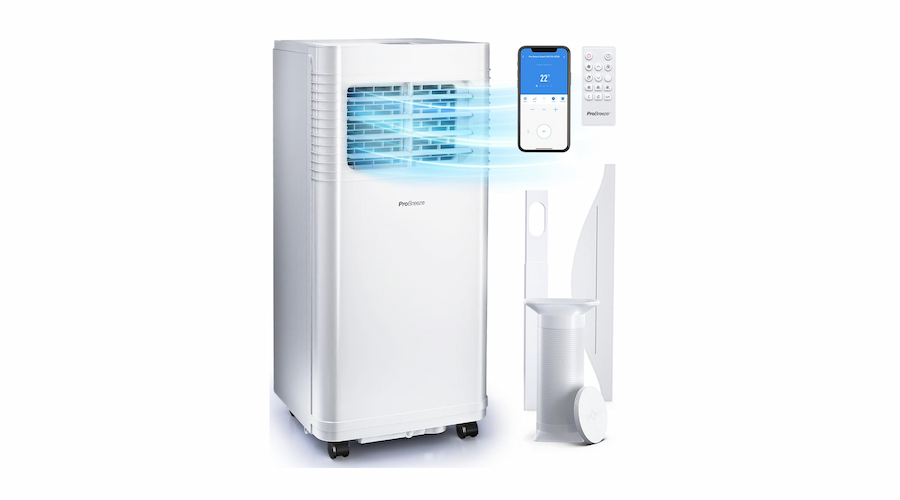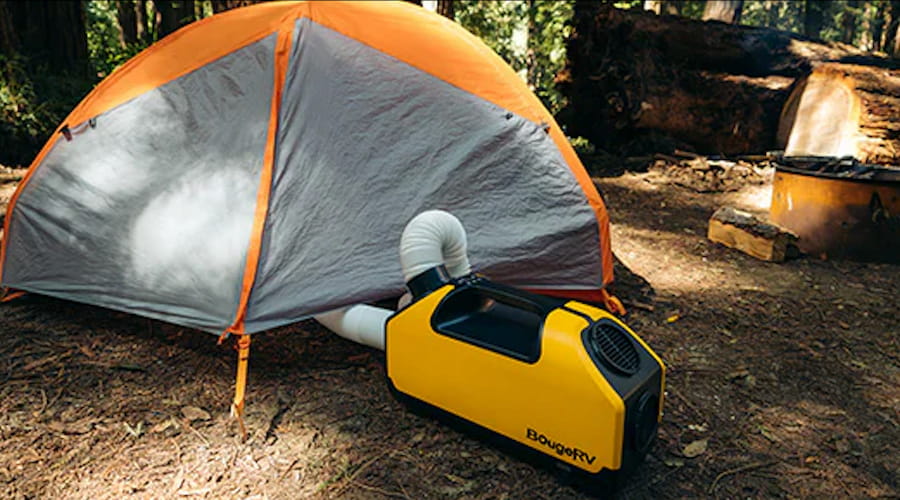Best Camping Air Conditioner UK 2025: Stay Cool Outdoors
There’s nothing worse than trying to sleep in a tent or camper when it feels like an oven inside. UK summers might not always scorch, but when the heat does hit—or you’re parked up with no breeze—you’ll wish you’d packed a camping air conditioner.
The good news? You don’t need to lug around a bulky, power-hungry unit to stay cool on your next trip. Whether you’re camping off-grid or pitching up at a family-friendly site, there are clever, compact options that actually work.
In this guide, we’ll show you what to look for when buying a camping AC, reveal the top 5 models for 2025, and share smart setup and energy-saving tips to help you camp cooler and smarter.
What to Look for When Buying a Camping Air Conditioner
Not all portable AC units are built for the outdoors. When choosing an air conditioning unit for camping, the key is finding one that fits your tent or camper setup, keeps you cool efficiently, and doesn’t create more hassle than it’s worth.
Cooling capacity (BTU) vs tent size
To find the best portable air conditioners for outdoor activities, start by matching the cooling power to your space. Too small, and you’ll barely feel a difference; too big, and you’ll waste energy.
A good rule of thumb: measure the floor area of your tent (length × width) and multiply it by 20–25 to estimate the BTU you need.
For a standard four-person tunnel tent, you’ll usually need something in the 5,000 BTU range to stay comfortable.
Power source and energy use
Think about how you’ll power it. Portable air conditioners for camping typically run on mains hook-up (230V) or on 12/24V DC power from a leisure battery or portable power station.
Mains-powered units draw between 500–800W, while battery-friendly models sip 150–350W to stretch runtime.
Portability and weight
Most portable air conditioners weigh between 10 and 23 kg. If you’re camping with the car nearby or in a caravan, that’s manageable. If you’re pitching up at a festival or wild camping, look for lighter models with carry handles or wheels to make life easier.
Noise levels
Sleeping in a tent means you’re much more aware of noise. An air conditioner portable for camping that runs at 44–55 dB on its quiet mode (about as loud as a fridge) is ideal for overnight use. Anything above that could disturb light sleepers.
Venting and condensation
All compressor-based air conditioners need to vent warm air outside. Many come with dual-hose kits to improve efficiency and prevent backflow. It’s also worth checking how they handle condensation—look for self-evaporating systems or built-in drain pumps to avoid puddles on your groundsheet.
Smart features
Modern models often come with Wi-Fi or Bluetooth control, so you can switch them on from your phone and pre-cool your space before heading back to camp. Timers and eco-modes are great for saving power overnight.
2025 Top 5 Camping Air Conditioners in the UK
So, what is the best portable air conditioner for camping? Below are five top-rated models for 2025 that deliver strong performance, portability, and comfort for your next camping trip. Let’s see what each one has to offer:
Best Overall: EcoFlow WAVE 3 Portable Air Conditioner
The EcoFlow WAVE 3 Portable Air Conditioner isn’t just a cooler; it’s a heat-pump powerhouse designed for year-round comfort. You get 6,100 BTU cooling and 6,800 BTU heating, capable of dropping tent temps by around 8°C in just 15 minutes—or boosting them on chilly mornings.
The clip-on 1,024Wh LFP battery gives you up to eight hours of runtime in Eco mode—no mains hook-up needed—and recharges to 100% in about 2-3 hours via AC or 400W solar. Despite its power, the WAVE 3 weighs only 15.6 kg (main unit), has a compact footprint, and a single-hand carry recess, so you can haul it from boot to pitch without drama.
Smart app control lets you schedule cooling, monitor battery status, and even get a ping when the internal condensate tank needs a quick tip. Under the hood, R290 refrigerant cuts Global Warming Potential, dual-hose venting maintains efficiency, and noise dips to 44 dB in Sleep mode—about the hum of a hotel mini-fridge.
It’s perfect for serious campers who want a proper climate-control experience in their tent, awning, or campervan.
EcoFlow WAVE 3 Portable Air Conditioner
Key features
6,100 BTU cooling / 6,800 BTU heating
Clip-on 1,024 Wh LFP battery with 8h runtime
Max 1 kW (AC + solar) input: fast charge in 75 min, 400W solar, 12/24V DC inputs
Compact and lightweight: 15.6 kg (unit) + 9.7 kg (battery)
44–58 dB noise range
Dual-hose venting and self-drain system
App and voice-assistant control
Best for Portability: Zero Breeze Mark 3 AC
At 10 kg, the ZERO BREEZE Mark 3 is one of the lightest true compressor air conditioner you can take camping. Despite its compact size, it delivers 5,280 BTU of cooling and 5,800 BTU of heating.
Its modular design includes clip-on battery packs for 5+ hours of runtime, and it can recharge via mains, 12/24V car outlets, or solar.
Features like Rocket mode for rapid cooling and Sleep mode for quieter nights make it a versatile choice for tents, campervans, or boats.


Key features
5,280 BTU cooling / 5,800 BTU heating
Supports solar charging up to 500W
10 kg (unit) + stackable battery packs
Rocket mode for fast cooling
Best for Larger Tents: Coolzy-Pro Portable Air Conditioner
The Coolzy-Pro is designed to deliver a targeted column of cold air to keep you comfortable without trying to chill the entire tent, so it feels stronger than the spec sheet suggests. With 3,650 BTU of cooling power and a low 340W draw, it’s energy-efficient enough for most electric hook-ups and modest power stations.
Weighing 15.4 kg, it’s easy to carry for its size, and the self-evaporating design means you don’t need to fuss with drain hoses for short trips. Pair it with the optional tent saddle to funnel cold air directly into large cabin tents for maximum effect.


Key features
3,650 BTU cooling, 340W consumption
Directional airflow design
15.4 kg; 45–54 dB noise range
Self-evaporating system
Best Budget Option: Pro Breeze 5,000 BTU Smart Portable Air Conditioner
If you’re camping on an electric hook-up and want solid cooling on a budget, the Pro Breeze 5,000 BTU is hard to beat. With an A-class energy rating and 560W power draw, it keeps running costs down.
It’s a bigger unit at 22 kg with a 68 cm height, so it’s better suited to family tents, caravans, or glamping setups where you can roll it into place using its caster wheels. The included vent hose can exit through a tent doorway, and Wi-Fi control lets you manage settings from your phone or smart speaker.


Key features
5,000 BTU cooling, 560W draw
Wi-Fi app + voice control compatibility
22 kg; caster wheels for mobility
24-hour timer
Best for Energy Efficiency: BougeRV 2,899 BTU Portable Air Conditioner
This compact BougeRV 2,899 BTU air conditioner is built for campers who need low power draw and maximum portability. Running natively on 24V DC and sipping just 250W, it’s ideal for pairing with power stations or leisure batteries on off-grid trips.
At around 10 kg, it’s lightweight and small enough to tuck away when not in use. The digital display, quiet 45 dB operation, and multiple fan speeds make it great for cooling two-person tents or micro-campers without draining your battery.


Key features
2,899 BTU cooling, 250W draw
Works on 24V DC + 230 V AC adapter
≈10 kg; ultra-portable size
Digital display with 3-speed fan
How to Set Up and Use Your Camping Air Conditioner
A camping air conditioner can be a game-changer for summer trips, but only if you set it up properly. From venting warm air to managing power, here’s how to keep your tent or van cool:
Start with placement: Position the unit on flat ground near a doorway or zipped vent so the exhaust hose can reach outside without twisting or sagging. Keep it out of direct sunlight if you can, and leave at least 30 cm of clearance on all sides to allow airflow.
Check your power supply: On campsites, most electric hook-ups provide 10A (around 2.3kW) or 16A (around 3.7kW). Make sure your combined appliances won’t overload it. If you’re running off-grid, remember portable air conditioners can spike to 1,200–1,500W when the compressor kicks in, so use a power station or inverter that can handle those surges.
Vent the hot air effectively: A portable AC needs to expel warm air outside to work properly. Fit the window kit or hose outlet through a vent, door, or a custom-cut ventilation panel securely, keeping the hose as straight and short as possible to avoid efficiency loss.
Manage condensation: Many modern units are self-evaporating, but in very humid weather they may still need draining. Use the built-in drain plug or a small condensate pump to channel water away into a bucket or outside.
Run it smart: Pre-cool your tent or van in the late afternoon while mains or solar power is available, then switch to eco or sleep mode overnight to reduce noise and save energy. Using a timer avoids the unit running longer than needed.
Energy-Saving Tips for Using a Camping Air Conditioner
Running a camping air conditioner efficiently is all about smart setup and good habits. Here are some simple ways to get more cooling while using less power:
Pitch your tent in the shade: Avoid direct sunlight to reduce how hard your air conditioner needs to work.
Cool the space early: Turn on the unit before your tent gets too warm. It uses less energy to maintain a cool temperature than to cool down a hot one.
Keep doors and vents closed: Seal up the tent while cooling. Openings allow warm air in and force the unit to work harder.
Use eco or sleep mode at night: Many models come with energy-saving settings that maintain comfort while reducing output.
Insulate your tent: Ground mats, thermal liners, and reflective covers help retain cool air. Pack a few camping essentials like blackout tarps or mesh window panels to help manage temperature and airflow.
Clean the filter regularly: A clean filter improves airflow and helps the unit run more efficiently with less strain on the power supply.
Conclusion
Bringing a camping air conditioner on your outdoor adventures can make a huge difference in comfort, sleep quality, and overall enjoyment. Whether you’re heading out for a weekend getaway or a longer off-grid trip, choosing the right unit and using it efficiently will help you stay cool without unnecessary hassle.
From powerful all-rounders like the EcoFlow WAVE 3 to budget picks for small tents, there’s something out there to fit every camper’s setup and budget.
FAQs
How to get air conditioning while camping?
You can get air conditioning while camping by using a portable camping air conditioner. These compact units work much like home AC systems but are designed to run on mains hook-ups, car sockets, batteries, or even solar power. If you’re staying on an electric hook-up site, you can use a standard portable AC.
For off-grid trips, battery-powered options like the EcoFlow WAVE 3 offer true flexibility, running for up to 8 hours in Eco mode with its clip-on battery and charging via mains, solar, or car. Venting hot air outside and managing condensation are key to making any camping air conditioner work effectively.
Are there air conditioners for tents?
Yes, there are air conditioners specifically designed for tents. These are usually compact, portable units that can cool a small enclosed space without drawing excessive power. Some models are ideal for electric hook-up sites, while others, like the EcoFlow WAVE 3, include battery packs and multiple charging options to keep you cool off-grid.
They work best when the tent is well-ventilated, with a hose directing warm air outside through a door or vent zip. For larger family tents, it’s worth choosing a unit with higher BTU output and a dual-hose system for better efficiency.
Do 12V air conditioners work?
12V air conditioners do work, but they’re designed for small, well-insulated spaces like compact tents, campervans, or truck cabs. They draw far less power than mains-powered models but won’t cool large areas as effectively.
If you’re camping off-grid, a higher-powered portable AC like the EcoFlow WAVE 3 may be a better option. It delivers 6,100 BTU cooling power, runs on mains, 12V/24V DC, or solar and offers up to 8 hours of battery runtime—ideal for those who want proper cooling without a constant hook-up.